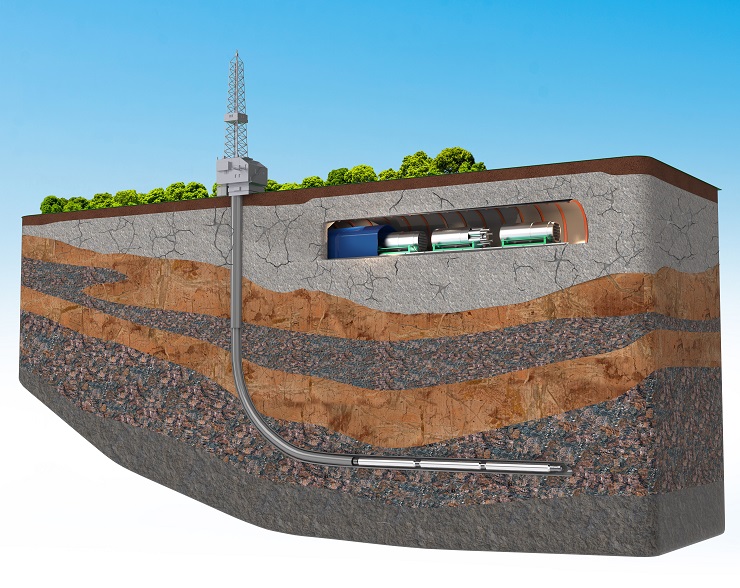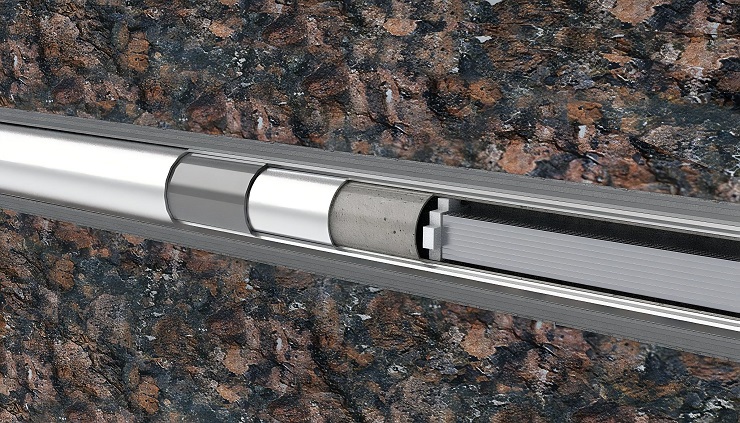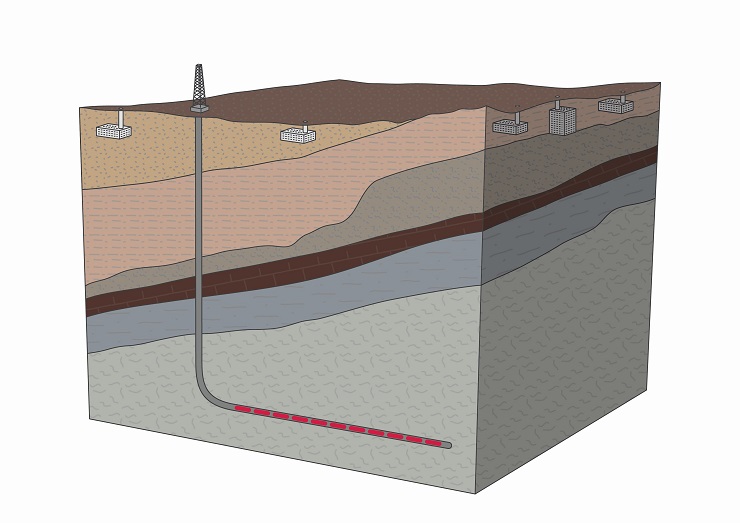
Nuclear power may be the new green, except for one considerable problem. The nuclear power industry struggles to get rid of its toxic waste. As recently stated, “deep geological repositories (DGR) are the globally preferred and scientifically proven solution to store high-level waste”. However, this hinges on how you define ‘deep.’ Current DGR sites are really mislabeled as they are planned to be a mere 60m to 800m below ground level. In terms of high-level waste, that is totally inadequate. To be truly effective, DGRs must be significantly deeper.
Since the 1970s, several countries have sought to manage the disposal of nuclear waste. In spite of those efforts, the waste product is still here and accumulating with no solution in sight. However, today there is an alternative solution. A deep horizontal wellbore disposal system drilled in a closed geological formation, 3000 metres or more below the surface.
Time to dig deep
All current ‘deep’ repository plans or efforts are in fact near surface storage and aim to dispose of high-level waste in shallow surface tunnels or mines. Many are so shallow they are actually in the existing water table.
Although alternative solutions have been available and known in the public domain since the late 1990s, the agencies responsible for current designs appear fully committed to blindly following each other, each spending billions of dollars over several decades developing ‘one-shot’ DGR systems. In such systems, a flaw or mistake discovered at any point in this process will mean a total loss, with all the years and dollars invested being wasted. With no shortage of time and money invested, what is missing is innovation. Nothing has changed in the waste technology since the efforts to establish the Yucca Mountain repository in the US more than 40 years ago, a shuttered site properly emblematic of the current DGR ‘solution.’
As the long-running issues faced at Yucca Mountain demonstrate, near-surface repositories may be of questionable merit. Developers anticipate that by installing bentonite ‘backfill’ or titanium ‘umbrellas’, these add-ons may guarantee some protective longevity, all at extreme costs and risks. However, any man-made protection exposed to water will be unable to withstand corrosion for the amount of time necessary. Luckily, an alternative solution already exists: disposal in deep horizontal wellbores, drilled and completed below 3000 metres deep in solid rock zones. This is a better solution for many reasons. The deep horizontal disposal repository in closed geological formations reaches far below any known water table. This disposal operation is also possible today. And it is much less expensive. For these reasons, it is a superior alternative to the current near-surface DGR systems.
Deep horizontal wellbores – built-in redundancy
Firstly, wellbore repository systems are drilled vertically downward to at least 3,000 metres (10,000 feet) below the surface, far deeper than existing DGR systems. Next, the wellbores are turned, extending horizontally for at least 5000 metres laterally. The lateral section can then be reamed out to the desired wellbore diameter. As shown in the below figure, this innovative drilling operation provides a continuous closed communicative pathway, from the surface, inside multiple durable steel casings which are lined externally with robust cement annuli.

While a novel application, the design is a modification of oilfield downhole tools that have been in use for many years. This engineering approach is the core of an industry which drills more than 61,000,000 m of horizontal wellbores each year in the United States alone. It is robust, reliable, rapid, and easily replicable. Existing drill rig systems have the necessary mechanical capacity and operational versatility to drill and ream out large diameter horizontal wellbores 3000 metres below the surface while rigs have lift capacity in excess of 450 tonnes of dead weight. This equipment is standard, currently active and drilling wells around the world. The required types of high-level waste horizontal wellbores can be realistically drilled today. There are thousands of horizontal wellbores in which a multiplicity of down-hole tools, production equipment, and completion systems are in use today in oil and gas exploration. If required, high-level waste can be deconstructed and reconstructed to fit into cylinders at the dimensions deemed most efficient, and the wellbore can be engineered to fit.
As an economic way to make available deep geological repositories in a short time and at a relatively low cost, it stands in stark contrast to current methods. Furthermore, a massive base of technological knowledge exists, with experienced technical services companies who can support implementation.
The horizontal wellbore is also lined with multiple steel casings and surrounded by a well-designed cement matrix. This provides yet another secure layer, in addition to the natural protection of the impermeable rock repository formation.
Cylindrical waste capsules can be robotically inserted from the surface, through the vertical section before ‘landing’ safely in the horizontal wellbore. Resting the capsules horizontally in the wellbore eliminates any added weight which occurs when stacking vertically. The individual waste capsules inside are sealed in place, many thousands of metres below the ecosphere, in a hydraulically closed rock zone. After storing capsules safely in the repository, the vertical wellbore can be sealed.

As the above figure shows, a simple surface marker is all that remains where a 40,000-tonne atomic bomb was successfully detonated more than 2,500 metres (8,000 feet) underground during operations to stimulate (frack) the deep gas-bearing shale formations in Colorado in the USA. After the deep horizontal repository system is closed permanently a similar surface marker would be the only visible reminder that tonnes of nuclear waste are buried thousands of metres below the surface. Additional warnings against intrusive drilling within several miles of the site would also be required. Storing the waste so deep would also render any retrieval efforts by bad actors practically impossible.
Protecting groundwater
Even after decades without any significant progress or success, groups continue to follow each others’ lead, excavating and developing mining systems in near-surface waste repositories in or near the water table. Without exception, geologists agree that these near-surface rocks are fissured and fractured – it is a fact of nature. The presence of these fissures and fractures allows fluid migration to occur. Many recent studies have concluded that surface rainwater may reach these repository layers in less than 50 years, creating corrosion problems for the stored capsules. This has been technically confirmed by analysis in migrating surface rainwaters.

For example, chlorine-36 is a chlorine radionuclide, present in rainwater at certain stable and predictable concentrations. It can be used to ‘fingerprint’ water with respect to age. Chlorine-36 occurs in all rainwater trickling down to near-surface mines and tunnels. The presence of this isotope in water in these near-surface systems is a flashing red light. Elevated ratios of Chlorine-36 found in what is nominally called ‘modern water’ have been caused by the detonations associated with atomic bomb testing in the atmosphere in the 1950s. Those high ratios did not exist pre-1950s. It indicates that in the near surface HLW disposal systems, ‘modern water’ has reached downward into these disposal zones.
Exhaustive analysis of chlorine-36 levels, in the interstitial waters surrounding and permeating the near-surface layers of the earth, shows conclusively surface waters continue to migrate downward, reaching any stored HLW material. The inevitable chemical, physical, and electrolytic degradation of HLW materials stored in the repository shall occur, regardless of any subsequent artificial protective systems, such as titanium umbrella sheets.
Safe disposal of high-level waste must be done in very deep formations to preclude the deleterious and disastrous effects of any possible downward fluid percolation over geologic time. No man-made protection within reach of water will be able to sustain its protection for the extraordinary period of time required for high-level waste storage.
Supporters of near-surface mining techniques indicate their solution to the water migration problem is the use of titanium ‘umbrellas,’ retroactively fitted to protect the capsules, and also the use of bentonite material as a repository ‘backfill’ which ‘swells’ to mitigate fluid flow in the capsule zone. It is difficult to see how these measures can maintain the required level of safety for a minimum of 10,000 years, much less than for the geological time scale needed for safe waste disposal.
The better solution is to design and implement a deep repository in a location where there is no chance of fluid flow into or out of the system. Such a system must be inside a massively impermeable rock zone, at great enough depths such that no downward migration of surface water can ever reach it. This is the key basis for the selection of deep horizontal wellbore storage.
In addition, we can also learn a lot from ongoing oilfield fracking operations which have provided insight into the ability of rock to allow fluid migration. The ‘tight’ nature of the deep fracking zones means they are initially non-productive. In order for fluid to enter into these zones, engineers must use ultra-high pressure pumps, with surface pressures up to 19,800 psi. Without these extremely high pressures, no fluid flows into the rock matrix. It can be inferred from the massive effort required that very little flow would occur out of the repository rock because of the extremely low permeability. Thus, the use of the deep horizontal wellbore in these very tight rock zones is best suited for safe waste disposal.
Better late than never
There are still many who are sceptical of the deep horizontal wellbore approach. While it is true that this horizontal wellbore system has not been done before, there has never been a DGR implemented on the planet either. However, there are several hundred thousand successful horizontal wellbores in operation around the world today. We should be asking why billions have been unquestionably and unsuccessfully wasted on continued DGR efforts for decades, and why we have not yet moved on to a better solution.
It is a myth that mines and tunnels are better repository sources because you can ‘see, feel, and monitor’ the rock face. Such erroneous, archaic thinking flies entirely and blatantly in the face of the massive knowledge base of petrophysical and exploratory analytical technologies and systems which have been developed in the oil and gas industry. The industry uses extremely advanced downhole tools and sophisticated AI computational systems. These tools allow scientists, engineers, and researchers to look into and scientifically examine rocks over large distances in and around wellbores. They provide rock and fluid properties in 2D, 3D and sometimes 4D, with exacting precision. This analysis allows billion-dollar exploration decisions to be made without ever personally ‘looking at’ the rock face thousands of metres below the surface. These analytical systems work.
It should be emphasised that the waste capsule should not be considered the ultimate protector of the waste but rather a 10,000-year container device whose primary purpose is to safely handle the waste on the surface and to safely transport it to the deep geological repository. The ultimate protector of the waste is the impermeable rock. The intrinsic properties of the rock, its size, depth, and low permeability are the actual long-term protective system.
Impact, high reward
There are many reasons why massive near-surface operations are not the best, nor even appropriate solution for nuclear waste disposal. These operations require thousands of workers on the surface, as well as hundreds working underground with built-in safety, ventilation, transport, and escape systems. These large and fully staffed, ‘mining’ type operations are expensive, dangerous, inefficient, and long-term undertakings. Furthermore, such complex operations are prone to catastrophic human error which can stop a project in its tracks. A recent ‘incident’ in a near-surface disposal operation occurred at the US Dept. of Energy’s WIPP facility in New Mexico. An air shaft malfunction and radioactive leak problem shut down operations for years, necessitating a billion-dollar fix.

Conversely, SuperLAT technology allows the disposal of thousands of tonnes of high-level waste capsules in a single deep horizontal wellbore. It forms a safe deep repository for waste in deep impermeable rock formations. Waste in cylindrical capsular form can be quickly and easily placed in these deep repositories which can be drilled in mere months. Such repositories would be ready for the safe disposal of all the waste produced by small modular reactors (SMR) as soon as the waste sufficiently cools at the cooling ponds. Not only are SuperLATTM systems significantly less prone to human error, but the resources to resolve any issue and restart are also minuscule compared to existing DGR operations. Robust, well-developed, and available today, it costs millions, not billions. A typical SuperLATTM operation can involve less than 30 workers on the surface to drill, load, and dispose of more than one million pounds of encapsulated waste at a cost of less than $50 million and a repository can be implemented in less than six months.
Very, very deep disposal repositories provide a timely solution to today’s high-level waste problem and they should form the basis for revitalising the nuclear power industry worldwide. With such a reliable and proven alternative to the conventional approach, it is time to rethink high-level waste disposal.
Getting to the core of the problem
Some researchers have recently indicated that the industry should ‘jumpstart’ a national dialogue by looking into a new deep wellbore high-level waste (HLW) disposal programme. They advise drilling a single well to implement geological and petrophysical analysis. Their hope is to quantify the technical suitability of the selected site for high-level waste disposal. This single well, another example of the ‘one shot’ approach, is incorrect, wasteful, and unnecessary.
First, a single test well would provide minimal and statistically unreliable information on the applicability of the deep formation’s suitability for high-level waste disposal. A large-scale, detailed analysis must be regional to obtain usable quantitative formation data. A single wellbore is a costly misuse of funds as it provides minimal data on which to base billion-dollar decisions.
Second, and more importantly, researchers have failed to realise that a massive amount of geological data already exists. There is no need to drill a single new wellbore to obtain it. For example, in the US alone, there are more than 37 state core libraries where rock core samples are available for inspection and analysis. These cores were collected from drilled wellbores, and represent drilling data from thousands of wells in hundreds of different rock formations. To demonstrate the data already available for inspection, the North Dakota core library alone has more than 304,800 metres (1,000,000’) of core samples. In Texas and other states, the availability of real core data for analysis of deep formations is even larger, and also readily available at almost no cost. With thousands of wells already drilled, proof of deep wellbores’ viability, and where to most safely and efficiently drill them, already exists.
Commercial core libraries are another readily available source of information. These private comprehensive libraries are well-maintained, and up-to-date, and are provided by both large and small exploration companies for their private use. The HLW industry can utilise these assets at a relatively low cost, and significantly more cheaply than that of drilling wells for the sole purpose of extracting samples.
This article first appeared in Nuclear Engineering International magazine.






